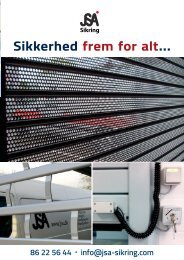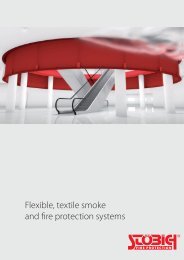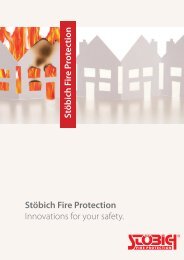Brandgardiner fra Stoebich giver tryghed
Create successful ePaper yourself
Turn your PDF publications into a flip-book with our unique Google optimized e-Paper software.
Flexible, textile smoke<br />
and fire protection systems<br />
®<br />
FIRE PROTECTION
®<br />
FIRE PROTECTION<br />
stoebich.com
TABLE OF CONTENTS<br />
GLOBAL MARKET LEADER FOR BUILDING-BASED<br />
FIRE PROTECTION<br />
2<br />
SMOKE CURTAINS<br />
4<br />
SMOKE PROTECTION CLOSURES<br />
8<br />
FIRE PROTECTION CURTAINS<br />
10<br />
1
®<br />
FIRE PROTECTION<br />
• Reliable protection<br />
against flames and smoke.<br />
• Successful since 1980.<br />
• Safety through engineering.<br />
• Global market leader<br />
‚made in Germany‘.<br />
2<br />
stoebich.com
THE RIGHT PROTECTION CONCEPT<br />
Global market leader for building-based fire protection<br />
The company Stöbich Brandschutz GmbH develops, manufactures<br />
and installs individual and standard structural fire protection<br />
solutions across the world and is one of the most innovative<br />
global leaders in the industry. Since 1980 this Goslar-based<br />
family company has been making its marks in the field of fire<br />
and smoke shielding systems. The developments began more<br />
than 30 years ago with the invention of the first fire protection<br />
closures for non-separated continuous transport systems. In addition<br />
to the conveyor system closure division, Stöbich has also<br />
become a specialist and market leader in textile fire protection<br />
over the past 20 years. Using state-of-the-art high-performance<br />
fabrics at the production site in Lower Saxony, the company produces<br />
textile fire protection solutions for almost all application<br />
areas that are distinguished by their flexibility in terms of design<br />
and architecture.<br />
3
®<br />
FIRE PROTECTION<br />
Smoke curtains<br />
• 90 % of all fire casualties are killed by smoke.<br />
Smoke curtains DIN EN 12101-1<br />
A smoke curtain is part of a smoke clearance system that also<br />
comprises other parts such as natural smoke and heat extraction<br />
units (EN 12101-2) and mechanical smoke and heat extraction<br />
units (EN 12101-3). Smoke curtains limit the movement of<br />
fire vapours within a building in the event of fire.<br />
Smoke clearance primarily involves protecting persons by maintaining<br />
good visibility, whilst heat extraction primarily focuses<br />
on protecting the building and the safety of the fire service team<br />
when fighting fires. However, the benefits of smoke and heat<br />
extraction should always be seen in combination in the context<br />
of person protection and the protection of property. For<br />
instance, ensuring good visibility not only serves the rescue of<br />
persons, but also early and targeted extinguishing of the fire by<br />
the fire service, which ultimately helps to preserve the building.<br />
Minimum building regulation requirement<br />
CE symbol<br />
In Part B of the List of Construction Rules in section 1.17.3, CE<br />
conformity with EN 12101-1 is specified as proof of usability.<br />
According to test standard EN 12101-1, the following tests<br />
are required:<br />
Fire test, endurance function test, fabric leak test and building<br />
materials class of the entire smoke curtain with respect to the<br />
fire behaviour.<br />
4<br />
stoebich.com
EXCERPT OF SMOKE CURTAINS<br />
The smoke extraction concept and the associated requirements<br />
for the smoke curtains can be defined based on: DIN 18232-2 und 5,<br />
Calculation method DIN 18232-2 and 5 model tests<br />
Residual opening in the overlap area<br />
We supply smoke curtains up to 50 metres in one piece, therefore<br />
0 % leak rate in the overlap area. This prevents a possible<br />
residual opening.<br />
Residual opening near the edge<br />
Rod guide guarantees positive-locking fabric edge clamping<br />
across the entire height. Therefore leaks near the edge under<br />
compression load 0%. Residual openings under compression<br />
load near the edge are avoided.<br />
Residual opening through deflection<br />
The heavy weight of the closure strips of 4.6 to 13.5 kg/m<br />
means that they do not sway as much and prevents any leakage<br />
problems.<br />
Space requirements<br />
Our construction is designed for minimum space requirements<br />
across the entire width. For our systems with corresponding<br />
control system and higher drive output, regardless of<br />
the unrolling length and 30 m system width, one doe snot<br />
require a drive aggregate for every module.<br />
Ceiling closure and closing direction<br />
Our system also offers a more attractive closure strip stopper to<br />
the ceiling mirror with a spring-bound closure strip or shadow<br />
groove joint. The systems can close in different directions and<br />
fits into your protection concept.<br />
Reaction time and unwinding length<br />
Unwinding speeds are achieved that reach an unwinding length<br />
of 8,500 mm to 20 m in 60 seconds.<br />
Temperature class<br />
We satisfy higher safety concept standards and can supply our<br />
systems in various temperature and time classes.<br />
5
®<br />
FIRE PROTECTION<br />
Safe escape routes<br />
Smoke removal systems<br />
optimised<br />
Cross currents<br />
are influenced<br />
Escape routes for<br />
Person flows<br />
Protection objectives<br />
Our smoke curtains offer safety for escape and emergency<br />
routes. The systems are flexibly adapted to the local situation in<br />
order to meet the requirements of the smoke curtain classification<br />
in terms of leaks, temperature loads and time classes.<br />
Smoke curtains optimise the efficiency of smoke extraction<br />
systems. The higher the smoke layer, the smaller the exhaust<br />
air opening surfaces and the 1.5 times larger supply air opening<br />
surfaces.<br />
In the case of cross-currents that hinder the extraction of the<br />
smoke as a result of the weather - especially in high rooms -<br />
smoke curtains are used to ensure safe currents.<br />
If in unfavourable situations in buildings the escape routes<br />
need to be combined with smoke curtains, the continuous and<br />
passable system Stripecoil is an alternative. Large flows of persons<br />
(depending on the width of the system, approx. 200 person/minute)<br />
can pass through the curtain<br />
with no significant restrictions. Handicapped persons with mobility<br />
equipment or children‘s prams can also escape without any<br />
additional effort through the separately designed fabric strips of<br />
the Stripecoil system.<br />
6<br />
stoebich.com
PROTECTION OBJECTIVES<br />
Better fire-fighting<br />
for the fire service<br />
Room division for<br />
mechanical smoke<br />
extraction<br />
Clearance of the field<br />
of vision<br />
Very low weight<br />
The formation of smoke sections prevents smoke spreading<br />
throughout the room. This makes it easier to identify the actual<br />
source of the fire, and the fire service can fight the fire more<br />
easily.<br />
have the advantage of being very lightweight, about 1 kg/m 2 ,<br />
and allowing continuous tubes, ventilation ducts or cable trays<br />
to be shielded easily.<br />
Smoke curtains serve to divide rooms for mechanical smoke<br />
extraction. This means much lower investment costs.<br />
Hidden smoke curtains not only satisfy architectural standards in<br />
terms of function and protection, they also ensure that the field<br />
of vision remains clear.<br />
Permanently installed smoke curtains made of textile structures<br />
7
®<br />
FIRE PROTECTION<br />
SMOKE PROTECTION CURTAINS<br />
• 70 % of all damage is caused by smoke.<br />
Smoke protection curtains<br />
DIN EN 18095 acc. to approval Z-6.62-2264<br />
When closed, smoke curtains (RSV) prevent smoke entering<br />
whilst a fire is developing so that the room behind the smoke<br />
curtain can be used to rescue humans and animals and there is<br />
enough time to save property without having to use respiratory<br />
equipment.<br />
8<br />
stoebich.com
SMOKE PROTECTION CURTAINS<br />
Small or large openings in walls can be sealed in a smoke-tight<br />
manner even if there is little space available and without compromising<br />
the architectural concept.<br />
These automatic system are very small and therefore very easy<br />
to integrate. If there are additional fire-resistance requirements,<br />
fire protection fabrics are used to achieve the protection objectives<br />
up to E 120, EW 90 and up to EI 120 in connection with<br />
compensation measures.<br />
In the case of openings in fire compartment ceilings, it is<br />
possible to close these in a smoke-tight manner in line with<br />
the protection objectives despite there being little space or architectural<br />
considerations. Thanks to its small size, little space is<br />
required to install these automatic system and they satisfy the<br />
wishes of design-conscious architects ideally (additionally tested<br />
based on DIN EN 1634-3 und DIN EN 1363-1).<br />
Low entrance openings in underground garages can be<br />
shielded by subdividing large rooms or, in the case of entrances<br />
or exits, taking into the account the space available in the camber<br />
area and at the side of the opening.<br />
Stöbich systems ensure that smoke cannot be transferred from<br />
one storey to the next or from one room to another via the elevator<br />
shafts.<br />
Fire loads in escape routes according to MBO are not allowed. In<br />
the event of fire, our products guarantee safety, even if there are<br />
drink or snack dispensing machines in niches in corridors<br />
or screens installed in walls thereby creating a certain fire load.<br />
Also, safe shielding is achieved in nurses‘ rooms or receptions<br />
without the need for the usual walls or glass panes which would<br />
disturb communication required for day-to-day operations.<br />
The connection between kitchens and canteens in hazardous<br />
areas is shielded securely with out smoke curtains without<br />
any great restrictions.<br />
9
®<br />
FIRE PROTECTION<br />
Smoke tightness<br />
This is the capability of a part to reduce or prevent the passage<br />
of smoke from one side of the door to the other side. The following<br />
performance levels are defined:<br />
DIN EN 13501-2:<br />
S 200<br />
: if the largest leak rate, measured both at the ambient temperature<br />
and also at 200°C and up to a pressure of 50 Pa is not<br />
exceeded for a single-leaf door system 20m 3 /h and for a two-leaf<br />
door system 30m 3 /h<br />
Products: Fiberseal-RS-1, Fiberseal-H<br />
S a<br />
: if the maximum leak rate, measured at ambient temperature<br />
and up to a pressure of just 25 Pa does not exceed the value of<br />
3m 3 /h per metre gap length between the fixed and mobile parts<br />
of the door unit (e.g. between the door leaf and door <strong>fra</strong>me),<br />
except the leak at the sill.<br />
Products: Fiberseal-RS-1, Fiberseal-H<br />
DIN 18095-3:<br />
RS: The leak rate of the door with respect to the normal state at<br />
a differential pressure during the test between 0 and 50 Pa may<br />
not be greater than 200°C both at room temperature (between<br />
10°C and 40°C) and also at the test medium (air) temperature<br />
- 20 m 3 /h for single-leaf smoke curtain doors<br />
- 30 m 3 /h for two-leaf smoke curtain doors.<br />
- 50 m 3 /h for single and two-leaf smoke curtain gates<br />
Smoke curtains should be handled in the same way as singleleaf<br />
smoke protection doors.<br />
Products: Fiberseal-RS-1, Fiberseal-H<br />
10<br />
stoebich.com
SMOKE PROTECTION CLOSURES<br />
Differences to textile closure systems and gates<br />
Fire protection doors and gates are generally used for standard<br />
situations. However, the use of textile closure systems offers significant<br />
benefits over conventional solutions:<br />
1. A curtain needs little space. The fabric is placed in small<br />
cases so that they can be fitted into and onto existing ceiling<br />
systems and hidden. There are no swivel areas that need to be<br />
kept free, and also no valuable space is required compared to a<br />
sliding gate.<br />
2. A further advantage of the fabric technology is that it can<br />
close very large openings. Stöbich Brandschutz has a general<br />
building authority approval for up to 7 x 4.5 m.<br />
3. A smoke curtain has a very low weight. Just a few dozen<br />
kilograms per running metre need to be taken into account in<br />
the plans. Our systems can also be installed on lightweight wall<br />
systems.<br />
4. There are significant costs savings to be made if textile<br />
systems are used to close large openings.<br />
5. Functional reliability is high because no rubbing sealing<br />
system can impact on the closing process and the sealing function.<br />
11
®<br />
FIRE PROTECTION<br />
FIRE PROTECTION CURTAINS<br />
• Fire protection that is concealed.<br />
Fire protection curtains<br />
Fire protection curtains serve to close wall of ceiling openings<br />
in the event of a fire. Their constructional design (unrolling and<br />
folding equipment) and the use of various fabrics opens up a<br />
wide application spectrum and different protection objectives<br />
or classifications and time classes. Cases and guide rails of the<br />
flexible systems are combined almost invisibly into the building<br />
structure and offer lots of design freedom for complex open<br />
room concepts.<br />
Large openings in walls and ceilings that create fire compartments<br />
can be closed in line with protection objectives even<br />
though there is little space available or architectural requirements<br />
need to be considered. These automatic system are very<br />
small and therefore very easy to integrate into the architecture.<br />
The demands on fire protection curtains are high especially in<br />
buildings with representative architectural concepts. Usually<br />
they need to be installed invisibly and seal off the room. Also,<br />
in some cases room-creating curtains needs to go around corners<br />
so that several walls or glass panels are not needed. This<br />
can be achieved without restriction by using lateral guide rails or<br />
columns. The fire protection curtain Fibershield-S creates a polygon-like<br />
room without the need for annoying guide rails that are<br />
needed to achieve the required level of tightness.<br />
12<br />
stoebich.com
FIRE PROTECTION CURTAINS<br />
The flat case design (12 cm in standard model) allows easy integration<br />
into the ceiling.<br />
If a building or building parts meet across corners or facade<br />
openings with small building clearances and are separated<br />
by a fire wall, there may be no openings within a distance<br />
of 5 m from the fire wall. This does not apply if the buildings or<br />
building parts come together at an angle of more than 120°over<br />
the corner.<br />
This requirement can be achieved by using Fibershield-P and<br />
Fibershield-F systems: designed for inside and outside buildings<br />
and proven thousands of times over. In these tight and selfclosing<br />
shielding systems, standard windows (VSG) without fire<br />
protection panes are used. The user profits from the unrestricted<br />
use of the windows and room comfort.<br />
Roofs of attached parts, which are connected to wall with openings<br />
or to walls that are not at least fire-retardant, need to be as<br />
fire resistant as the ceilining of the connected building within a<br />
distance of 5 m from these walls.<br />
Textile fire protection closures are installed in the building to<br />
prevent the transfer of fire from one storey to another and<br />
are controlled by fire alarm systems automatically, for instance by<br />
means of thermal triggers in the event of a fire.<br />
Fire risks for machines and systems that are at special risk are limited<br />
by the creation of sections within fire compartments.<br />
The walls and ceiling necessary for this can be created with the<br />
Fibershield closures. Also, the rooms created in this way are flooded<br />
with high-pressure mist extinguishing systems or gas extinguishing<br />
systems to put out the fire. The Fibershield closure<br />
systems are designed depending on the allowed leaks. Due to<br />
the strict tightness requirements for gas extinguishing systems,<br />
systems with guide rails are used.<br />
13
®<br />
FIRE PROTECTION<br />
Brick partition (E)<br />
is the capability to withstand<br />
the fire so that the penetration<br />
of flames or hot vapours can be<br />
prevented.<br />
E 90, E 120, E 240<br />
Brick partition with<br />
Limitation of the<br />
radiation penetration (EW)<br />
Radiation limitation is the ability<br />
to reduce fire transfer to neighbouring<br />
materials by means of<br />
radiated heat.<br />
EW 30, EW 60, EW 90, EW120<br />
Heat insulation<br />
in case of exposure to fire with<br />
dense sprinkler protection (E +<br />
Sprinkler)<br />
Heat insulation is the ability to<br />
prevent fire transfer by means of<br />
heat. The transfer must be limited<br />
so that neither the surfaces facing<br />
away from the fire nor materials<br />
close to these surfaces ignite and<br />
persons can be protected.<br />
Protection objectives such as: EI 90,<br />
EI 120, EI 180<br />
Protection objectives/classifications<br />
The creator of the fire protection certificate must observe the<br />
technical building provisions and achieve the general protection<br />
goals (see MBO 2002 §3(1)) and the fire protection objectives (see<br />
MBO 2002 §15). It is possible to deviate from these technical building<br />
provisions if the protection objectives can be implemented<br />
equivalently using a different solution (e.g. a fire protection curtain,<br />
possible in connection with compensation measures) (see<br />
MBO 2001 §3(3)).<br />
14<br />
stoebich.com
CLASSIFICATION<br />
Heat insulation<br />
in case of exposure to fire with<br />
water film (E + Water film)<br />
(surface temperature is less than<br />
the allowed limit values)<br />
EI 90, EI 120, EI 180<br />
Heat insulation<br />
Fire effect without water<br />
(EI dry)<br />
EI 30, EI 60, EI 90, EI 120<br />
Prevention of<br />
flames spreading from storey<br />
to storey (with) railing (storey<br />
spread)<br />
The necessary 1m high railing<br />
(camber) is automatically<br />
created in the event of a fire.<br />
In accordance with the general building approval Z6-60-2127<br />
the fire protection curtain is able to prevent flames and smoke<br />
from entering for 90 minutes (see E90 according to DIN EN 13501<br />
Part 2, tested to DIN EN 1634 Part 1). Any thermal insulation effect<br />
required to reach the protection goal can be realised alternatively<br />
by means of the described measures. Proof of suitability<br />
is provided by one or several test reports.<br />
The following table describes which protection goals (not classifications)<br />
that are conventionally reached in compliance with<br />
the technical building provisions (stated classifications according<br />
to DIN EN 13501 Part 2, tested to DIN EN 1634 Part 1), can<br />
be implemented alternatively by the installation of a fire protection<br />
curtain.<br />
15
®<br />
FIRE PROTECTION<br />
16<br />
stoebich.com
YOUR PROJECT-SPECIFIC DOCUMENTS<br />
One-stop-shop<br />
The company Stöbich Brandschutz is part of the Stöbich Group.<br />
Thanks to the numerous upstream and downstream activities by<br />
other companies in the group, we are able to bundle and confirm<br />
the quality of our competence, know-how and work in all<br />
processes and to ensure the quality of our actions.<br />
One-stop-shop!<br />
17
®<br />
FIRE PROTECTION<br />
STÖBICH BRANDSCHUTZ - THE GLOBAL MARKET LEADER<br />
Stöbich dealers/sales partners<br />
Stöbich branch offices<br />
International sales partners or branch offices<br />
· Armenia<br />
· Australia<br />
· Austria<br />
· Azerbaijan<br />
· Bahrain<br />
· Belgium<br />
· Brazil<br />
· Bulgaria<br />
· Canada<br />
· Chile<br />
· China<br />
· Colombia<br />
· Croatia<br />
· Cyprus<br />
· Denmark<br />
· Estonia<br />
· Finland<br />
· France<br />
· Georgia<br />
· Greece<br />
· Great Britain<br />
· Hong Kong<br />
· Hungary<br />
· India<br />
· Ireland<br />
· Iceland<br />
· Islamic Rep. of Iran<br />
· Israel<br />
· Italy<br />
· Kazakhstan<br />
· Kyrgyzstan<br />
· Latvia<br />
· Lebanon<br />
· Liechtenstein<br />
· Lithuania<br />
· Luxembourg<br />
· Malaysia<br />
· Macedonia<br />
(FYROM)<br />
· Moldavia<br />
· New Zealand<br />
· Norway<br />
· Paraguay<br />
· Peru<br />
· Poland<br />
· Portugal<br />
· Qatar<br />
· Romania<br />
· Russia<br />
· Saudi Arabia<br />
· Sweden<br />
· Switzerland<br />
· Serbia<br />
· Singapore<br />
· Slovakia<br />
· Slovenia<br />
· Spain<br />
· Tajikistan<br />
· Taiwan<br />
· Thailand<br />
· The Czech Republic<br />
· The Netherlands<br />
· Turkey<br />
· Turkmenistan<br />
· Ukraine<br />
· Uruguay<br />
· USA<br />
· Uzbekistan<br />
· United<br />
Arab Emirates<br />
· White Russia<br />
German Branch Offices<br />
Branch office North/headquarters<br />
Stöbich Brandschutz GmbH<br />
Pracherstieg 6<br />
38644 Goslar<br />
Telefon +49 (0) 5321 5708-19<br />
Telefax +49 (0) 5321 5708-88<br />
Branch office South<br />
Stöbich Brandschutz GmbH<br />
Gewerbehof 8<br />
73441 Bopfingen<br />
Telefon +49 (0) 7362 9614-0<br />
Telefax +49 (0) 7362 9614-50<br />
Branch office East<br />
Stöbich Brandschutz GmbH<br />
Geltestraße 12<br />
06188 Landsberg OT Queis<br />
Telefon +49 (0) 34602 552-0<br />
Telefax +49 (0) 34602 552-50<br />
Branch office West<br />
Stöbich Brandschutz GmbH<br />
Max-Planck-Straße 13<br />
59423 Unna<br />
Telefon +49 (0) 2303 98689-17<br />
Telefax +49 (0) 2303 98 689-50<br />
01.2017 Nr.1- KS
















